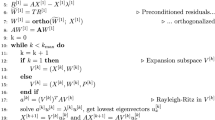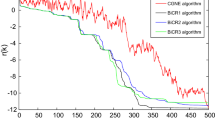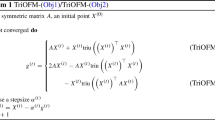Abstract
The locally optimal block preconditioned 4-d conjugate gradient method (LOBP4dCG) for the linear response eigenvalue problem was proposed by Bai and Li (2013) and later was extended to the generalized linear response eigenvalue problem by Bai and Li (2014). We put forward two improvements to the method: A shifting deflation technique and an idea of extending the search subspace. The deflation technique is able to deflate away converged eigenpairs from future computation, and the idea of extending the search subspace increases convergence rate per iterative step. The resulting algorithm is called the extended LOBP4dCG (ELOBP4dCG). Numerical results of the ELOBP4dCG strongly demonstrate the capability of deflation technique and effectiveness the search space extension for solving linear response eigenvalue problems arising from linear response analysis of two molecule systems.
Similar content being viewed by others
References
Anderson E, Bai Z, Bischof C, et al. LAPACK Users’ Guide, 3rd ed. Philadelphia: SIAM, 1999
Bai Z, Li R-C. Minimization principles for the linear response eigenvalue problem, I: Theory. SIAM J Matrix Anal Appl, 2012, 33: 1075–1100
Bai Z, Li R-C. Minimization principle for the linear response eigenvalue problem, II: Computation. SIAM J Matrix Anal Appl, 2013, 34: 392–416
Bai Z, Li R-C. Minimization principles and computation for the generalized linear response eigenvalue problem. BIT Numer Math, 2014, 54: 31–54
Carson E. Communication-avoiding Krylov Subspace Methods in Theory and Practice. PhD thesis. Berkeley: University of California, 2015
Carson E, Demmel J. Accuracy of the s-step Lanczos method for the symmetric eigenproblem in finite precision. SIAM J Matrix Anal Appl, 2015, 36: 793–819
Demmel J. Applied Numerical Linear Algebra. Philadelphia: SIAM, 1997
Flaschka U, Lin W-W, Wu J-L. A KQZ algorithm for solving linear-response eigenvalue equations. Linear Algebra Appl, 1992, 165: 93–123
Giannozzi P. QUANTUM ESPRESSO: A modular and open-source software project for quantum simulations of materials. J Phys Condensed Matter, 2009, 21: 395502
Golub G, Ye Q. An inverse free preconditioned Krylov subspace methods for symmetric eigenvalue problems. SIAM J Sci Comput, 2002, 24: 312–334
Golub G H, Van Loan C F. Matrix Computations, 3rd ed. Baltimore-Maryland: Johns Hopkins University Press, 1996
Hetmaniuk U, Lehoucq R. Basis selection in LOBPCG. J Comput Phys, 2006, 218: 324–332
Imakura A, Du L, Sakurai T. Error bounds of Rayleigh-Ritz type contour integral-based eigensolver for solving generalized eigenvalue problems. Numer Algor, 2016, 71: 103–120
Knyazev A V. Toward the optimal preconditioned eigensolver: Locally optimal block preconditioned conjugate gradient method. SIAM J Sci Comput, 2001, 23: 517–541
Kovač-Striko J, Veselić K. Trace minimization and definiteness of symmetric pencils. Linear Algebra Appl, 1995, 216: 139–158
Lancaster P, Ye Q. Variational properties and Rayleigh quotient algorithms for symmetric matrix pencils. Oper Theory Adv Appl, 1989, 40: 247–278
Li R-C. Rayleigh quotient based optimization methods for eigenvalue problems. In: Bai Z, Gao W, Su Y F, eds. Matrix Functions and Matrix Equations, vol. 19. Series in Contemporary Applied Mathematics. Singapore: World Scientific, 2015, 76–108
Li R-C, Zhang L-H. Convergence of block Lanczos method for eigenvalue clusters. Numer Math, 2015, 131: 83–113
Liang X, Li R-C. Extensions of Wielandt’s min-max principles for positive semi-definite pencils. Linear Multilinear Algebra, 2014, 62: 1032–1048
Liang X, Li R-C, Bai Z. Trace minimization principles for positive semi-definite pencils. Linear Algebra Appl, 2013, 438: 3085–3106
Marques M A, Castro A, Rubio A. Assessment of exchange-correlation functionals for the calculation of dynamical properties of small clusters in time-dependent density functional theory. J Chem Phys, 2001, 115: 3006–3014
Money J, Ye Q. EIGIFP: A MATLAB program for solving large symmetric generalized eigenvalue problems. ACM Trans Math Software, 2005, 31: 270–279
Olsen J, Jensen Aa H J, Jørgensen P. Solution of the large matrix equations which occur in response theory. J Comput Phys, 1988, 74: 265–282
Olsen J, Jørgensen P. Linear and nonlinear response functions for an exact state and for an MCSCF state. J Chem Phys, 1985, 82: 3235–3264
Quillen P, Ye Q. A block inverse-free preconditioned Krylov subspace method for symmetric generalized eigenvalue problems. J Comput Appl Math, 2010, 233: 1298–1313
Ring P, Schuck P. The Nuclear Many-Body Problem. New York: Springer-Verlag, 1980
Rocca D. Time-Dependent Density Functional Perturbation Theory: New algorithms with Applications to Molecular Spectra. PhD thesis. Trieste: The International School for Advanced Studies, 2007
Rocca D. Iterative diagonalization of non-hermitian eigenproblems in time-dependent density functional and manybody perturbation theory. Boston: Presentation at Session B39, the APS Marching Meeting, 2012
Saad Y. On the rates of convergence of the Lanczos and the block-Lanczos methods. SIAM J Numer Anal, 1980, 15: 687–706
Teter M, Payne M, Allan D. Solution of Schr¨odinger equation for large systems. Phys Rev B, 1989, 40: 12255–12263
Thouless D J. Vibrational states of nuclei in the random phase approximation. Nuclear Phys, 1961, 22: 78–95
Thouless D J. The Quantum Mechanics of Many-Body Systems. New York: Academic, 1972
Tsiper E V. Variational procedure and generalized Lanczos recursion for small-amplitude classical oscillations. JETP Letters, 1999, 70: 751–755
Wen Z, Zhang Y. Block algorithms with augmented Rayleigh-Ritz projections for large-scale eigenpair computation. Technical report. ArXiv:1507.06078, 2015
Ye Q. An adaptive block Lanczos algorithm. Numer Algor, 1996, 12: 97–110
Zhou Y, Li R-C. Bounding the spectrum of large Hermitian matrices. Linear Algebra Appl, 2011, 435: 480–493
Author information
Authors and Affiliations
Corresponding author
Rights and permissions
About this article
Cite this article
Bai, Z., Li, R. & Lin, W. Linear response eigenvalue problem solved by extended locally optimal preconditioned conjugate gradient methods. Sci. China Math. 59, 1443–1460 (2016). https://doi.org/10.1007/s11425-016-0297-1
Received:
Accepted:
Published:
Issue Date:
DOI: https://doi.org/10.1007/s11425-016-0297-1




